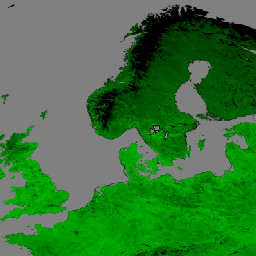
- 데이터 세트 제공
- 2012-01-17T00:00:00Z–2025-09-30T00:00:00Z
- 데이터 세트 제공업체
- NASA LP DAAC at the USGS EROS Center
- 주기
- 8일
- 태그
설명
Suomi National Polar-Orbiting Partnership (S-NPP) NASA 가시광선 적외선 이미징 방사계 제품군 (VIIRS) 식생 지수 (VNP13A1) 데이터 제품은 500미터 해상도에서 16일 획득 기간 동안 사용 가능한 최적의 픽셀을 선택하는 프로세스를 통해 식생 지수를 제공합니다. VNP13 데이터 제품은 지구 관측 시스템 (EOS) 미션의 연속성을 촉진하기 위해 중간 해상도 이미징 분광계 (MODIS) Terra 및 Aqua 식생 지수 제품군을 따라 설계되었습니다.
VNP13 알고리즘 프로세스는 (1) 정규 식생 지수 (NDVI), (2) 향상된 식생 지수 (EVI), (3) 향상된 식생 지수-2 (EVI2)의 세 가지 식생 지수를 생성합니다. (1) NDVI는 적색 및 근적외선 (NIR) 대역을 모두 사용하여 원격으로 감지된 가장 긴 연속 시계열 관측 중 하나입니다. (2) EVI는 NDVI보다 캐노피 피복에 더 민감한 약간 다른 식생 지수입니다. NDVI는 엽록소에 더 민감합니다. (3) EVI2는 적색 대역과 NIR 대역을 사용하여 표준 3대역 EVI를 개혁한 것입니다. 이 개혁은 파란색 밴드를 포함하지 않는 다른 EVI 모델과 VIIRS EVI를 비교할 때 발생하는 문제를 해결합니다. EVI2는 결국 표준 EVI가 됩니다.
이 제품에는 3개의 식생 지수 레이어와 함께 근적외선(NIR) 반사율, 3개의 단파 적외선(SWIR) 반사율(빨간색, 파란색, 녹색 반사율), 합성 연중일, 픽셀 신뢰도, 시야각 및 태양각, 품질 레이어가 포함되어 있습니다.
자세한 내용은 VIIRS Land Product Quality Assessment 웹사이트를 방문하여 User Guide를 참고하세요.
문서:
대역
픽셀 크기
500m
대역
| 이름 | 단위 | 픽셀 크기 | 파장 | 설명 | |||||||||||||||||||||||||||||||||||||||||||||||||||||||||||||||||||||||||||||||||||||||||||||||
|---|---|---|---|---|---|---|---|---|---|---|---|---|---|---|---|---|---|---|---|---|---|---|---|---|---|---|---|---|---|---|---|---|---|---|---|---|---|---|---|---|---|---|---|---|---|---|---|---|---|---|---|---|---|---|---|---|---|---|---|---|---|---|---|---|---|---|---|---|---|---|---|---|---|---|---|---|---|---|---|---|---|---|---|---|---|---|---|---|---|---|---|---|---|---|---|---|---|---|---|
EVI |
미터 | 없음 | 3밴드 향상된 식생 지수 |
||||||||||||||||||||||||||||||||||||||||||||||||||||||||||||||||||||||||||||||||||||||||||||||||
EVI2 |
미터 | 없음 | 2밴드 향상된 식생 지수 |
||||||||||||||||||||||||||||||||||||||||||||||||||||||||||||||||||||||||||||||||||||||||||||||||
NDVI |
미터 | 없음 | 정규 식생 지수 |
||||||||||||||||||||||||||||||||||||||||||||||||||||||||||||||||||||||||||||||||||||||||||||||||
NIR_reflectance |
미터 | 846~885nm | 근적외선 반사율 |
||||||||||||||||||||||||||||||||||||||||||||||||||||||||||||||||||||||||||||||||||||||||||||||||
SWIR1_reflectance |
미터 | 1230~1250nm | 단파 적외선 반사율 |
||||||||||||||||||||||||||||||||||||||||||||||||||||||||||||||||||||||||||||||||||||||||||||||||
SWIR2_reflectance |
미터 | 1580~1640nm | 단파 적외선 반사율 |
||||||||||||||||||||||||||||||||||||||||||||||||||||||||||||||||||||||||||||||||||||||||||||||||
SWIR3_reflectance |
미터 | 2225~2275nm | 단파 적외선 반사율 |
||||||||||||||||||||||||||||||||||||||||||||||||||||||||||||||||||||||||||||||||||||||||||||||||
VI_Quality |
미터 | 없음 | 품질 평가 (QA) 비트 필드입니다. |
||||||||||||||||||||||||||||||||||||||||||||||||||||||||||||||||||||||||||||||||||||||||||||||||
red_reflectance |
미터 | 600~680nm | 빨간색 밴드 반사율 |
||||||||||||||||||||||||||||||||||||||||||||||||||||||||||||||||||||||||||||||||||||||||||||||||
green_reflectance |
미터 | 545~656nm | 녹색 밴드 반사율 |
||||||||||||||||||||||||||||||||||||||||||||||||||||||||||||||||||||||||||||||||||||||||||||||||
blue_reflectance |
미터 | 478~498nm | 파란색 밴드 반사율 |
||||||||||||||||||||||||||||||||||||||||||||||||||||||||||||||||||||||||||||||||||||||||||||||||
composite_day_of_the_year |
d | 미터 | 없음 | 연중 날짜 |
|||||||||||||||||||||||||||||||||||||||||||||||||||||||||||||||||||||||||||||||||||||||||||||||
pixel_reliability |
미터 | 없음 | 간단한 순위 클래스를 사용한 Pixel 유용성 |
||||||||||||||||||||||||||||||||||||||||||||||||||||||||||||||||||||||||||||||||||||||||||||||||
relative_azimuth_angle |
deg | 미터 | 없음 | 각 픽셀의 상대 방위각 |
|||||||||||||||||||||||||||||||||||||||||||||||||||||||||||||||||||||||||||||||||||||||||||||||
sun_zenith_angle |
deg | 미터 | 없음 | 각 픽셀의 태양 천정각 |
|||||||||||||||||||||||||||||||||||||||||||||||||||||||||||||||||||||||||||||||||||||||||||||||
view_zenith_angle |
deg | 미터 | 없음 | 각 픽셀의 천정각 보기 |
|||||||||||||||||||||||||||||||||||||||||||||||||||||||||||||||||||||||||||||||||||||||||||||||
pixel_reliability 클래스 표
| 값 | 색상 | 설명 |
|---|---|---|
| 0 | 없음 | 매우 좋음 |
| 1 | 없음 | 좋음 |
| 2 | 없음 | 허용됨 |
| 3 | 없음 | Marginal(한계) |
| 4 | 없음 | 통과 |
| 5 | 없음 | 출전 여부 불투명 |
| 6 | 없음 | 나쁨 |
| 7 | 없음 | Cloud Shadow |
| 8 | 없음 | 눈/얼음 |
| 9 | 없음 | Cloud |
| 10 | 없음 | 예상 |
| 11 | 없음 | LTAVG (데이터베이스에서 가져옴) |
이용약관
이용약관
LP DAAC NASA 데이터는 자유롭게 액세스할 수 있지만, 저자가 이러한 데이터를 게시하거나 데이터를 기반으로 작업하는 경우 저자는 게시물의 텍스트 내에서 데이터세트를 인용하고 참고 문헌 목록에 데이터세트를 포함해야 합니다.
인용
LP DAAC 데이터 세트 인용에 관한 자세한 내용은 LP DAAC '데이터 인용' 페이지를 참고하세요.
DOI
Earth Engine으로 탐색
코드 편집기(JavaScript)
var dataset = ee.ImageCollection('NASA/VIIRS/002/VNP13A1') .filter(ee.Filter.date('2017-05-01', '2017-06-30')); var rgb = dataset.select(['EVI']); var rgbVis = { min: 0.0, max: 1.0, palette: ['000000', '004400', '008800', '00bb00', '00ff00'], }; Map.setCenter(17.93, 7.71, 6); Map.addLayer(rgb, rgbVis, 'RGB');
